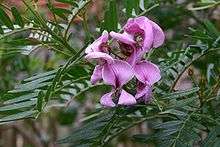Podalyrieae
| Podalyrieae | |
|---|---|
 | |
| Virgilia divaricata | |
| Scientific classification | |
| Kingdom: | Plantae |
| (unranked): | Angiosperms |
| (unranked): | Eudicots |
| (unranked): | Rosids |
| Order: | Fabales |
| Family: | Fabaceae |
| Subfamily: | Faboideae |
| (unranked): | Core genistoids |
| Tribe: | Podalyrieae (Benth.) Cardoso et al. 2013[1][2] |
| Genera[1][3] | |
|
See text. | |
| Synonyms[4] | |
| |
The tribe Podalyrieae is one of the subdivisions of the plant family Fabaceae.
Description
The Podalyrieae arose 30.5 ± 2.6 million years ago (in the Oligocene) in the fynbos (Cape Floristic Region) of South Africa and is still mostly found there.[5][6] All members of the tribe exhibit either nonsprouting or sprouting fire survival strategies.[7] Many species are pollinated by insects, especially carpenter bees,[4] while others are pollinated by sunbirds or rodents.[5]
The members of this tribe consistently form a monophyletic clade in molecular phylogenetic analyses.[1][4][5][8][9][10][11][12][13][14] The tribe does not currently have a node-based definition, but several morphological synapomorphies have been identified:
"imparipinnately compound leaves, axillary racemose inflorescences, carboxylic acid esters of quinolizidine alkaloids, and the isoflavone 3′-hydroxydaidzein as a major seed flavonoid"[1][5][15] as well as "strongly reduced or absent bracteoles and the occurrence of persistent antipodals in the female gametophyte."[4]
Subtribes and Genera
Subtribe Xiphothecinae
- Amphithalea Eckl. & Zeyh.
- Xiphotheca Eckl. & Zeyh.
Subtribe Podalyriinae
- Calpurnia E. Mey.
- Liparia L.
- Podalyria Willd.
- Stirtonanthus B.-E. van Wyk & A. L. Schutte
- Virgilia Poir.
Unassigned
References
- 1 2 3 4 Cardoso D, Pennington RT, de Queiroz LP, Boatwright JS, Van Wyk B-E, Wojciechowski MF, Lavin M. (2013). "Reconstructing the deep-branching relationships of the papilionoid legumes". S Afr J Bot 89: 58–75. doi:10.1016/j.sajb.2013.05.001.
- ↑ Wojciechowski MF. (2013). "Towards a new classification of Leguminosae: Naming clades using non-Linnaean phylogenetic nomenclature". S Afr J Bot 89: 85–93. doi:10.1016/j.sajb.2013.06.017.
- ↑ USDA, ARS, National Genetic Resources Program (17 January 2003). "GRIN species records of Podalyrieae". Germplasm Resources Information Network—(GRIN) [Online Database]. National Germplasm Resources Laboratory, Beltsville, Maryland. Retrieved 4 August 2010.
- 1 2 3 4 Schutte AL, Van Wyk B-E, Schutte-Vlok AL, Forest F., Van der Bank M. (1998). "Evolutionary relationships in the Podalyrieae and Liparieae (Fabaceae) based on morphological, cytological, and chemical evidence". Pl Syst Evol 209 (1–2): 1–31. doi:10.1007/BF00991521.
- 1 2 3 4 5 Boatwright JS, Savolainen V, Van Wyk B-E, Schutte-Vlok AL, Forest F., Van der Bank M. (2008). "Systematic position of the anomalous genus Cadia and the phylogeny of the tribe Podalyrieae (Fabaceae)". Syst Bot 33 (1): 133–147. doi:10.1600/036364408783887500.
- ↑ Linder HP. (2003). "The radiation of the Cape flora, southern Africa". Biol Rev Camb Philos Soc 78 (4): 597–638. doi:10.1017/S1464793103006171. PMID 14700393.
- ↑ Schutte AL, Vlok JHJ, Van Wyk B-E. (1995). "Fire-survival strategy—a character of taxonomic, ecological and evolutionary importance in fynbos legumes". Pl Syst Evol 195 (3–4): 243–259. doi:10.1007/BF00989299.
- ↑ Cardoso D, de Queiroz LP, Pennington RT, de Lima HC, Fonty É, Wojciechowski MF, Lavin M. (2012). "Revisiting the phylogeny of papilionoid legumes: new insights from comprehensively sampled early-branching lineages". Am J Bot 99 (12): 1991–2013. doi:10.3732/ajb.1200380.
- ↑ Käss E, Wink M. (1996). "Molecular evolution of the Leguminosae: Phylogeny of the three subfamilies based on rbcL-sequences". Biochem Syst Ecol 24 (5): 365–378. doi:10.1016/0305-1978(96)00032-4.
- ↑ Käss E, Wink M. (1997). "Phylogenetic Relationships in the Papilionoideae (Family Leguminosae) Based on Nucleotide Sequences of cpDNA (rbcL) and ncDNA (ITS 1 and 2)". Mol Phylogenet Evol 8 (1): 65–88. doi:10.1006/mpev.1997.0410. PMID 9242596.
- ↑ Doyle JJ, Doyle JL, Ballenger JA, Dickson EE, Kajita T, Ohashi H. (1997). "A phylogeny of the chloroplast gene rbcL in the Leguminosae: taxonomic correlations and insights into the evolution of nodulation". Am J Bot 84 (4): 541–554. doi:10.2307/2446030. PMID 21708606.
- ↑ Wink M, Mohamed GIA. (2003). "Evolution of chemical defense traits in the Leguminosae: mapping of distribution patterns of secondary metabolites on a molecular phylogeny inferred from nucleotide sequences of the rbcL gene". Biochem Syst Ecol 31 (8): 897–917. doi:10.1016/S0305-1978(03)00085-1.
- ↑ Crisp MD, Gilmore S, Van Wyk B-E. (2000). "Molecular phylogeny of the genistoid tribes of papilionoid legumes". In Herendeen PS, Bruneau A. Advances in Legume Systematics, Part 9. Royal Botanic Gardens, Kew. pp. 249–276. ISBN 184246017X.
- ↑ LPWG [Legume Phylogeny Working Group] (2013). "Legume phylogeny and classification in the 21st century: progress, prospects and lessons for other species-rich clades". Taxon 62 (2): 217–248. doi:10.12705/622.8.
- ↑ Van Wyk B-E. (2003). "The value of chemosystematics in clarifying relationships in the Genistoid tribes of papilionoid legumes". Biochem Syst Ecol 31 (8): 875–884. doi:10.1016/S0305-1978(03)00083-8.
- ↑ van der Bank M, Chase MW, van Wyk B-E, Fay MF, van der Bank FH, Reeves G, Hulme A. (2002). "Systematics of the tribe Podalyrieae (Fabaceae) based on DNA, morphological and chemical data". Bot J Linn Soc 139 (2): 159–170. doi:10.1046/j.1095-8339.2002.00051.x.
| Wikimedia Commons has media related to Podalyrieae. |
| Wikispecies has information related to: Podalyrieae |
This article is issued from Wikipedia - version of the Saturday, September 27, 2014. The text is available under the Creative Commons Attribution/Share Alike but additional terms may apply for the media files.